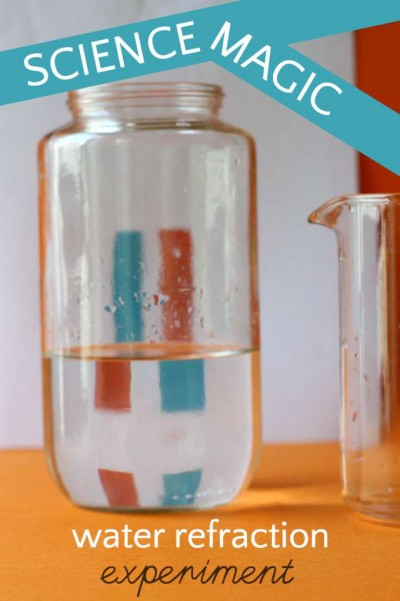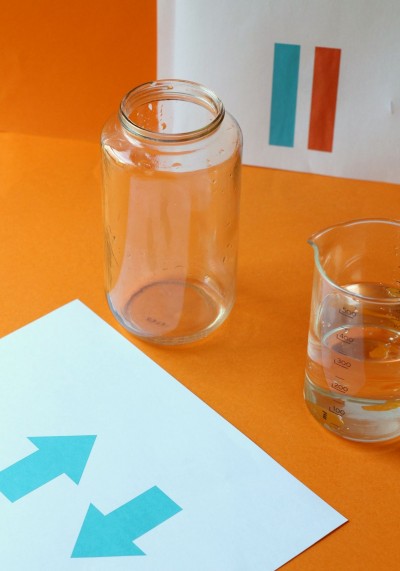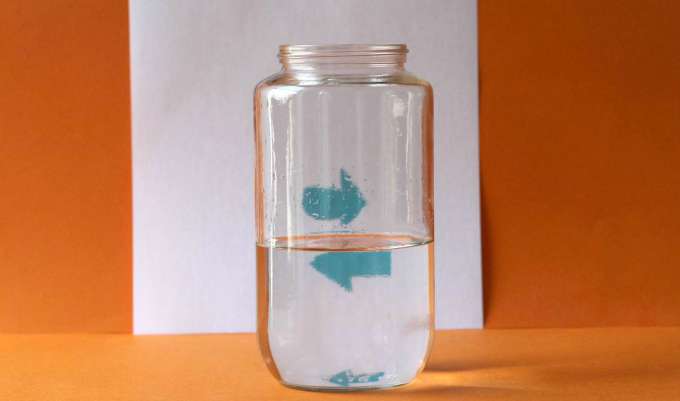This water refraction science experiment has such a "wow factor" and is so quick and easy I can't believe my kids and I haven't done it before. It would fit right in with our DIY science camp series, too. Best of all, there is almost no set up, but once I showed it to the kids, they experimented on their own and debated the reasons for the results. You have the option of setting up the science experiment as we did, or doing it right now with the glass of water sitting next to you!
Water Refraction Science Experiment
What you need:
- Water
- Jar or glass
- A paper with a design on it. If you wish, you can download and print our printable. It is two pages and includes the colored bars and two arrows.
Instructions:
Place a jar or glass about 6 inches in front of the colored bars or arrows. Pour in the water. What happens?
Watch the video!
To make it more fun:
Ask your kids to keep their eyes on the bars/arrows as you slowly pour the water into the jar.
I told my kids I had a magic liquid. I'm pretty sure my 6 year old believed me, but my 10 year old unconvincingly said, "It's water, mom." But then after I performed the experiment, he said, "Now try it with water." Ha! So I guess I did fool him.
Explorations:
- Does it make a difference how close the water is to the paper?
- Does it make a difference if the jar is square or round? What about the size of the jar or glass?
- Draw a diagram of what you think is happening to the light rays. (See explanation below)
- Super nerdy kids (I say that with love) can learn more about refraction of light here.
The science behind the water refraction experiment:
Refraction is the bending of light. In this case, light traveled from the air, through the front of the glass jar, through the water, through the back of the glass jar, and then back through the air, before hitting the picture. Whenever light passes from one medium into another, it refracts.
In addition, the water acts as a magnifying glass, which bends the light toward the center. The light comes together at the focal point and beyond the focal point the image looks reversed because the light that was on the right is now on the left, and vice versa. Clear as mud? (Note: I am not a science teacher and if you would like to correct or add to my explanation in the comments, I welcome it! Update: someone did! Read the comments for more scientific explanation of the refraction phenomena.)
Want another cool and magical water experiment?
- Find out how to make a coin jump from a bottle.
- Or find more fun indoor water activities for kids.








Maria Dermitzaki says
I would like to receive mails
Erica says
You can sign up here: https://www.whatdowedoallday.com/newsletter-sign
Eliana Nevarez says
we filled the glass half with water and put the arrow behind the glass and when we moved the arrow to a particular distance behind the glass it makes the arrow look like its going the other way. When light passes from one material to another, it can bend or refract. In the third experiment before hitting the arrow light traveled from the air, through the glass, through the water, through the back of the glass, and then back through the air. Anytime that light passes from one thing into another, it refracts. When light went through the glass the light bent toward the center. That’s where the light all came together this is called the focal point, but beyond the focal point the image reversed because the light rays that were bent pass each other and the light that was on the right side is now on the left and the left on the right and that is what makes the arrow looks reversed.
Sauli Jämsä says
You should be talking about light traveling FROM the picture TO your eyes.
Yes says
Light doesn't travel, it's just waves.
Rajni says
What is the prinsipal for this experiment
ayushi says
prinicipal - refraction of light.
person says
you spelt principal wrong
person says
ranji spelt principal wrong*
Mj says
It will just be same if the glass is not round?
Erica says
Might be a fun experiment to try it and find out. 😉
Ms. Right says
Everyone spelled it wrong. Principal = the leader of a school. Principle = theory of reasoning